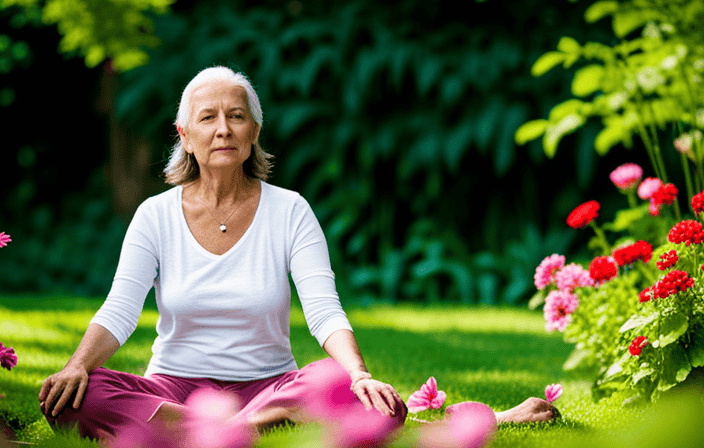Amidst the hustle and bustle of daily life, there is a powerful tool for peace and change: **meditation**. Journey into the world of inner calm and growth with this ancient practice that can bring balance and clarity to your hectic existence. Discover the secrets of meditation and unlock a path to serenity and self-improvement. Explore the wonders waiting within this timeless art and embark on a journey of enlightenment and inner peace. Take a step towards a more harmonious and fulfilled life by embracing the transformative power of meditation.
Through the centuries, this ancient practice has endured, offering a path to inner peace and self-discovery.
Just as the world swirls with noise and distractions, meditation invites us to find stillness within.
It is a powerful tool that allows us to cultivate self-awareness, unlock hidden potential, and foster a deeper connection with ourselves and others.
Join me on a journey into the transformative power of meditation, where we will uncover the keys to inner peace and personal growth.
Key Takeaways
- The goal of meditation is to cultivate inner peace, clarity, self-awareness, and a deeper understanding of oneself and the world.
- Meditation has numerous benefits, including improving clarity, focus, emotional balance, managing stress, and overall well-being.
- Meditation helps in developing mindfulness, observing thoughts and emotions, and connecting with the present moment, leading to self-awareness and inner peace.
- Meditation deepens the relationship with oneself, fosters empathy and compassion, and recognizes interconnectedness, leading to personal growth and transformation.
What is Meditation?
I’ve learned that meditation is a practice that aims to cultivate inner peace, self-awareness, and a deeper understanding of oneself and the world. It provides numerous benefits such as clarity, focus, emotional balance, stress management, and overall well-being.
Meditation has been around for centuries, with roots in ancient civilizations like India and China. Through this practice, one can develop mindfulness, observe their thoughts and emotions, and connect with the present moment. It helps in recognizing patterns and habits, enhancing self-understanding, and finding tranquility within.
This transformative practice deepens the relationship with oneself, develops empathy and compassion, and recognizes interconnectedness with others. It expands awareness beyond the self and has the power to enhance personal growth and cultivate positive qualities.
Embarking on a meditation journey requires patience, curiosity, an open mind, and consistent practice. By committing to this practice, one can unlock their transformative potential and cultivate inner peace and transformation.
Origins and History
The origins and history of meditation can be traced back to ancient civilizations in India and China, predating recorded history and remaining a topic of ongoing debate. It is fascinating to explore the roots of this transformative practice that has touched the lives of countless individuals throughout time.
Although it is difficult to attribute the origin of meditation to a single individual, the ancient sages and spiritual leaders of these civilizations played a significant role in its development and dissemination. They recognized the power of turning inward, cultivating stillness, and exploring the depths of the mind and consciousness.
Over time, meditation evolved and adapted, taking on different forms and techniques. Today, we have the privilege of continuing this ancient tradition, benefiting from the wisdom and knowledge passed down through generations. Through meditation, we can connect with our inner selves, find tranquility, and embark on a journey of self-discovery and transformation.
Buddha’s Enlightenment
After an extended period of meditation, I attained supreme awakening and became an enlightened one. Under the shade of the Bodhi tree, I embarked on a profound journey of self-discovery and transformation.
For 49 days and nights, I delved deep into the recesses of my mind, observing my thoughts and emotions with unwavering focus. Through this rigorous practice, I gained a profound understanding of the nature of suffering and the path to liberation.
My mind became clear, my heart filled with compassion, and I awakened to the interconnectedness of all beings. The experience of enlightenment brought me inner peace beyond words and a sense of purpose to guide others on their own journeys of self-realization.
Through meditation, we can all cultivate this inner peace and tap into the transformative power within ourselves.
Goal and Benefits
Through consistent practice and an open mind, one can discover the numerous benefits and the ultimate goal of meditation.
The goal of meditation is to cultivate inner peace, clarity, self-awareness, and a deeper understanding of oneself and the world. It is a transformative practice that has the power to bring about positive changes in our lives.
By meditating regularly, we can achieve clarity of mind, focus, emotional balance, and overall well-being. Meditation helps us manage stress, reduce anxiety, and find tranquility within ourselves. It allows us to observe our thoughts and emotions without judgment and connect with the present moment.
Moreover, meditation deepens our connection with ourselves and others, fostering empathy and compassion. It expands our awareness beyond the self and opens the door to personal growth and transformation.
Cultivating Self-Awareness
By practicing meditation, I can develop mindfulness, observe my thoughts and emotions, and connect with the present moment. It allows me to create a space of stillness within, where I can witness the ebb and flow of my inner world. Through this practice, I have learned to embrace the following aspects of self-awareness:
-
Awareness of my breath: As I focus on my breath, I become aware of the sensation of each inhalation and exhalation, grounding me in the present moment.
-
Observation of thoughts: Meditation teaches me to observe my thoughts without judgment. I witness the constant stream of thoughts passing through my mind, understanding that they do not define me.
-
Recognition of emotions: By practicing meditation, I can identify and acknowledge my emotions as they arise. This awareness helps me respond to them with compassion and understanding.
-
Cultivation of inner stillness: Through regular meditation, I am able to cultivate a sense of inner peace and stillness that extends beyond my meditation practice, influencing my daily life.
In this journey of self-awareness, meditation has become a powerful tool that allows me to deepen my understanding of myself and the world around me.
Connection and Transformation
In my meditation practice, I have discovered a profound connection with myself and others, leading to personal growth and the development of positive qualities. Through meditation, I have come to recognize the interconnectedness of all beings and the deep sense of unity that exists. This awareness has allowed me to cultivate empathy and compassion towards others, fostering a sense of connection that transcends boundaries and differences.
Meditation has the transformative power to break free from limitations and expand our awareness beyond the self. It has helped me to overcome negative patterns and habits, allowing for personal growth and the cultivation of positive qualities. Through consistent practice, I have experienced a deep sense of inner peace and clarity, enabling me to navigate life’s challenges with a greater sense of calm and resilience.
In my meditation journey, I have found that the benefits extend beyond the individual level. As I cultivate self-awareness and inner peace, I am able to create a ripple effect of positivity and transformation in my interactions with others. This connection and transformation are at the heart of the power of meditation, offering a path towards a more compassionate and harmonious world.
Embarking on the Journey
Embarking on this journey of self-discovery and growth has been a transformative experience for me. As I have delved deeper into the practice of meditation, I have come to realize the profound power it holds in cultivating inner peace and transformation.
Here are four key aspects that have resonated with me:
-
Patience: Meditation has taught me the importance of embracing patience. It is not a quick fix, but rather a gradual process of self-exploration and growth.
-
Curiosity: Approaching meditation with a curious mind has allowed me to uncover new insights and perspectives. It encourages me to explore the depths of my being and unravel the mysteries within.
-
Consistency: It is through regular and consistent practice that I have witnessed the most significant changes. The commitment to showing up for myself and engaging in meditation has nurtured a sense of discipline and dedication.
-
Open-mindedness: Keeping an open mind has been crucial in my meditation journey. It has allowed me to let go of preconceived notions and embrace the present moment with acceptance and non-judgment.
Through this journey, I have discovered that meditation is not only a tool for finding inner peace but also a catalyst for personal transformation. It has helped me cultivate a deeper understanding of myself and the world around me, fostering compassion and a greater sense of interconnectedness.
Exploring the depths of my consciousness has allowed me to uncover profound insights and foster personal growth. Through the practice of meditation, I have embarked on a journey of self-discovery and transformation. With patience and curiosity, I have delved into the realms of my mind, observing thoughts and emotions as they arise and fade away. This process has helped me develop mindfulness, connecting me with the present moment and cultivating a sense of inner peace.
By immersing myself in meditation, I have gained a deeper understanding of myself and the world around me. I have become more aware of my patterns and habits, allowing me to make conscious choices that align with my values and aspirations. Meditation has also opened my heart to the interconnectedness of all beings, fostering empathy and compassion.
In this journey, I have learned that meditation is not about escaping reality, but rather about embracing it fully. It has given me the tools to navigate life’s challenges with greater clarity and emotional balance. Through consistent practice, I have cultivated a profound sense of well-being and a renewed perspective on life.
I am grateful for the transformative power of meditation and the peace it has brought into my life.
Frequently Asked Questions
How long does it take to see the benefits of meditation?
It varies for each individual, but consistent meditation practice can start to show benefits within a few weeks. Regular practice helps cultivate inner peace, clarity, self-awareness, and emotional balance, leading to overall well-being and transformation.
Can meditation be harmful or have negative effects?
Meditation, harmful? Please. While rare, negative effects like increased anxiety or disassociation can occur. But with proper guidance and self-awareness, meditation is generally safe. Its benefits far outweigh the risks, leading to inner peace and transformation.
Are there different types of meditation practices?
Yes, there are different types of meditation practices. They vary in techniques, focuses, and traditions. Examples include mindfulness meditation, loving-kindness meditation, transcendental meditation, and many more. Each practice offers unique benefits and approaches to cultivating inner peace and transformation.
Can meditation help with physical health conditions?
Meditation has numerous benefits for physical health conditions. It can alleviate symptoms, reduce stress, improve immune function, and promote overall well-being. Through regular practice, I have experienced the transformative power of meditation on my own health.
Is meditation a religious practice or can it be practiced by anyone, regardless of their beliefs?
Meditation is not limited to any religious or belief system. It can be practiced by anyone seeking inner peace and transformation. Its benefits extend to individuals of all backgrounds, promoting self-awareness, clarity, and emotional well-being.









